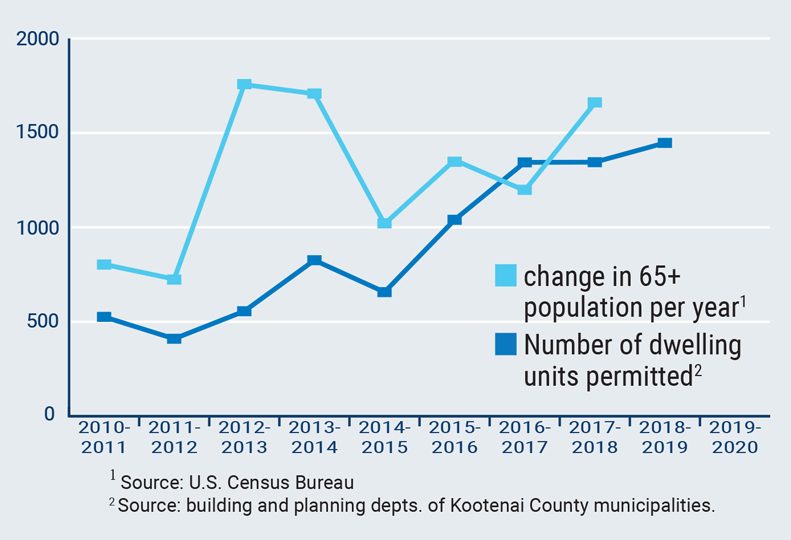
Home » North Idaho looks to accommodate influx of retirees
North Idaho looks to accommodate influx of retirees
Senior population growth outpaces housing stock

April 9, 2020
Kootenai County has experienced an influx of retirees moving into the region over the last decade, and builders have struggled to keep up with the demand for housing, some observers say.
This has led to concerns of a shortage of both retirement friendly and single-family homes to accommodate seniors.
“We’re definitely the Florida of the Northwest,” says Josh Suhr, Realtor with Windermere Coeur d’Alene Realty. “We’re already having a really hard time being able to build fast enough to meet our demand.”
Since 2001, the 65 and older population in North Idaho has more than doubled, growing to over 32,000 in 2019, from about 14,000 in 2001, says Sam Wolkenhauer, a Post Falls-based economist with the Idaho Department of Labor.
More than half of that growth can be attributed to in-migration, says Wolkenhauer. About 20% of the current population of Kootenai County is made up of those aged 65 or older. U.S. Census Bureau data show nationwide, those aged 65 and older account for 15.8% of the total population in 2018, the most recent year for which data is available.
From 2001 to 2019, the 65-and-older population grew by 110% in Kootenai County, according to data from the Idaho Department of Labor. During that same period, the population ages 40 to 64 grew 38%; ages 15 to 39 grew 31%; and the under-15 population grew 22%.
“It seems likely that a lot of it is due to the cost of living, lower traffic congestion, and it seems to be a more desirable pace and quality of life,” Wolkenhauer says. “It’s the Goldilocks zone for a lot of people who are looking for a place to retire.”
An informal survey of licensed retirement and 55-plus communities shows Kootenai County has at least 35 complexes totaling roughly 1,600 units. The most recent development appears to be a 40-unit retirement community named Monte Vista Villas, which was constructed in Coeur d’Alene in 2014.
Several communities built before 2014 have since undergone expansions to accommodate the demand for senior housing, including North Star Retirement, which added 14 units in 2017 to bring its total to 145 units. The Renaissance at Coeur d’Alene, which underwent an expansion in 2018, added 16 beds, bringing its total to 80 beds.
Throughout Idaho, there are about 2,460 facilities, and about 12,113 units, according to data compiled by the AARP Public Institute in 2013. That equals about 57 units per every 1,000 people aged 65 or older in Idaho.
Across the county, the number of senior facilities is on the rise, with construction of new senior housing up by 25% in the past decade, AARP reports.
A survey included in Kootenai County’s 2020 Comprehensive Plan Update notes 48% of respondents in Region 1, which includes Kootenai, Benewah, Bonner, Boundary, and Shoshone counties, felt the region had a need for housing for seniors, and 41% of respondents believe there is a need for elderly and other special needs groups. Statewide, 34% of respondents felt a need for more senior housing and 41% felt the need for elderly and other special needs groups.
It states, “Region 1 possesses a significantly greater need than the state as a whole in senior housing.”
Nationwide, senior housing was at 88% occupancy for the fourth quarter of 2019, according to data from the National Investment Center for Seniors & Housing Care, up 2.8% compared to the previous year. Data for Kootenai County is not available, but the Pacific Northwest region reported an occupancy of 90%, up 3.3% from fourth quarter 2018, according to data.
Naturally, not all retirees migrating to the area will choose to live in retirement or 55-and-older communities.
The 65-and-older population is projected to continue its upward trend, however, growing to 44,000 by 2029, or an additional 36%, Wolkenhauer says.
Municipalities in Kootenai County permitted just under 1,450 single-family homes in 2018, according to data compiled in the Journal’s annual Market Fact Book. As of February 2020, Kootenai County had about one-month of housing inventory available for sale, says Suhr.
“Our building has, over the last couple of years, had a hard time finding the skilled trades to build fast enough,” he adds. “But I think we definitely have the infrastructure in place to continue building and hopefully meet the demand.”
Suhr says he believes, if the economy were to go into a correction, it could help to slow and balance the current housing demand so builders could catch up.
“It’s very much a sellers’ market,” he says. “But recent events are obviously going to change that.”
Beyond that, Suhr says he has noticed a trend of single-family home builders adjusting building plans to include more senior-friendly features, such as zero-step entries and low-maintenance yards.
The city of Coeur d’Alene has also taken measures to adjust its accessory dwelling units code, Suhr adds, which allows homeowners to build accessory units on their property for use as mother-in-law suites, for example.
“The city of Coeur d’Alene itself was pretty progressive about trying to look at other nontraditional housing types, like an accessory dwelling unit,” he says. “(The city) just reworked their code for that to try and make it more feasible for people. I think things like that are going to be huge with people who have aging parents or want to get extra income from renting it out.”
Latest News Up Close Real Estate & Construction North Idaho
Related Articles
Related Products




